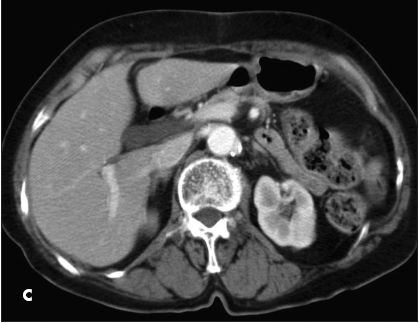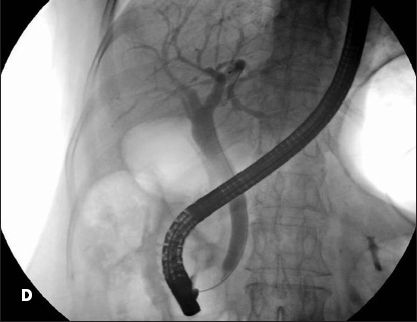Gallbladder Agenesis
A 60-year-old woman with a 3-month history of progressively worsening epigastric pain was referred for elective cholecystectomy after ultrasonography showed findings consistent with chronic cholecystitis (A and B). The patient reported having postprandial abdominal discomfort since 4 years of age. She also had occasional nausea and vomiting but denied jaundice, change in bowel habits, or urinary symptoms.
A 60-year-old woman with a 3-month history of progressively worsening epigastric pain was referred for elective cholecystectomy after ultrasonography showed findings consistent with chronic cholecystitis (A and B). The patient reported having postprandial abdominal discomfort since 4 years of age. She also had occasional nausea and vomiting but denied jaundice, change in bowel habits, or urinary symptoms.
Laboratory results, including liver enzyme levels, were normal. Results of previous right upper quadrant ultrasonography, upper GI series with small-bowel follow-through, gastric emptying study, upper endoscopy, and colonoscopy were normal. An abdominal CT scan showed a dilated common hepatic duct confluence; the gallbladder was not visualized (C).
Surgery revealed a large common bile duct at the level of the confluence between the right and left ducts at the hepatic hilum; the gallbladder was absent. A postoperative endoscopic retrograde cholangiopancreatography showed a mildly dilated proximal bile duct of 10 mm that slowly tapered to 8 mm distally; the cystic duct and gallbladder did not fill (D). Based on these findings and the history of midepigastric pain, the diagnosis of type II sphincter of Oddi dysfunction was entertained and an endoscopic sphincterotomy was performed.

At follow-up, the patient had reduced pain and increased appetite with associated weight gain. Congenital agenesis of the gallbladder is a rare anomaly (reported in 1 in 6334 live births) that results from either failed development of the caudal portion of the original hepatic sacculation or lack of proper vacuolization of the gallbladder primordium.1,2 The average age of presentation is 36 to 46 years. A female to male ratio of about 2 or 3 to 1 has been reported.3,4 Affected adults are usually healthy and have no other congenital anomalies. However, common bile duct stones, carcinoma of the biliary tract, and primary sclerosing cholangitis have been associated with gallbladder agenesis.3

A familial or inherited trait also has been described.4 In a study of 208 patients with gallbladder agenesis, symptoms included right upper quadrant pain (90%), nausea (66%), fatty food intolerance (37%), and jaundice (36%).5 In affected patients, symptoms suggestive of biliary tract disease develop in about 23%, liver enzyme levels are elevated in 30% to 60%, and radiographic studies are usually consistent with chronic cholecystitis.5-7
Hepatobiliary scans usually show the absence of the gallbladder and cystic duct filling, consistent with acute cholecystitis. For this reason, gallbladder agenesis is often discovered at celiotomy. However, cholangiography remains the most reliable method to demonstrate true absence of an extrahepatic or intrahepatic gallbladder.8
Because most patients become asymptomatic after laparotomy, it has been suggested that the common bile duct may dilate to assume the role of bile storage in place of the absent gallbladder.5 In turn, the dilated common bile duct may predispose to stone formation. The fact that patients with an otherwise normal pancreaticobiliary tree and right upper quadrant abdominal pain have a higher sphincter of Oddi resting pressure may explain why sphincterotomy also results in symptomatic improvement.9
References:
REFERENCES:
1.
Richards RJ, Taubin H, Wasson D. Agenesis of the gallbladder in symptomaticadults: a case and review of the literature.
J Clin Gastroenterol.
1993;16:231-233.
2.
Bloom RB, Fichtenberg H. Agenesis of the gallbladder: report of a case.
J Am Osteopath Assoc.
1981;81:62-64.
3.
Sterchi JM, Baine RW, Myers RT. Agenesis of the gallbladder: an inheriteddefect?
South Med J.
1977;70:498-499.
4.
Wilson JE, Deitrick JE. Agenesis of the gallbladder: case report and familialinvestigation.
Surgery.
1986;99:106-109.
5.
Bennion RS, Thompson JE Jr, Tompkins RK. Agenesis of the gallbladderwithout extrahepatic biliary atresia.
Arch Surg.
1988;123:1257-1260.
6.
Nadeau LA, Cloutier WA, Konecki JJ, et al. Hereditary gallbladder agenesis:twelve cases in the same family.
J Maine Med Assoc.
1972;63:1-4.
7.
Baltazar U, Dunn J, Gonzalez-Diaz S, Browder W. Agenesis of the gallbladder.
South Med J.
2000;93:914-915.
8.
Jackson RJ, McClellan D. Agenesis of the gallbladder. A cause of false-positiveultrasonography.
Am Surg.
1989;55:36-40.
9.
Meshkinpour H, Mollot M, Eckerling GB, Bookman L. Bile duct dyskinesia: clinical and manometric study.
Gastroenterology.
1984;87:759-762.